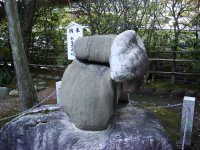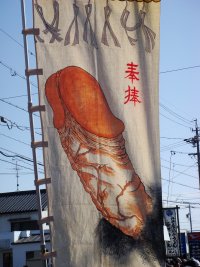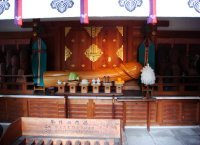



 
 


|
For most of the year, Tagata Jinja is very quiet. Most of the visitors are young couples, sometimes coming to pray for successful conception, sometimes coming to give thanks for safe child birth. Tagata's fertility festival, as with most festivals in Japan, is treated in a lighthearted way with much sake and noisy behavior. Modern Japanese society is less dependent on the vagaries of seasons and harvests and so the importance of agricultural traditions has faded, however it is obvious that people do take it seriously, solemnly approaching the permanent shrines and praying in silence. You see the occasional busload of tourists, but for the most part Tagata is silent.
The matsuri, known as the Hounen-sai, has always had the objective of ensuring a bountiful harvest. It is mostly a procession symbolizing the visit of the male Takeinadane to the powerful and waiting female Tamahime-no-mikoto. While not a matriarchal society, women held high social status in the Yamato period and after marriage were usually not required to join their husband's household. The young warrior Takeinadane probably visited his wife instead of living together. These visits are symbolized in the procession.
Each year, a new giant wooden phallus is carved from a large hinoki (cypress) tree. In Japan newly made objects are thought to express more purity and vitality. The tree is brought to the shrine for purification rituals during the coldest part of the winter before a master craftsman begins to shape it. The craftsman uses only traditional tools and wears clothing that has also been purified through rituals at the shrine. It is this phallus that will be the central focus of the procession, and then be placed into the Shinmeisha shrine as the principal phallus after the festival.
Originally the phallus was much smaller and attached to a straw effigy of a samurai warrior, possibly representing Takeinadane. However in time this was considered a bit too risqué even for a fertility ritual, so the effigy was discarded and the phallus was paraded by itself. As its size was still about three feet long, the phallus was paraded by itself, carried by four or five people. However, this practice was also altered with the partial shielding of the phallus by a small portable shrine (mikoshi), the same style that houses it today. As if to compensate for not being fully revealed, the size of the phallus has grown considerably over the years until it is now about 10 feet long and weighs about 620 pounds. It protrudes from both ends of the portable shrine, and when considering the extra weight of the later, the bearers are basically struggling under a weight of 885 pounds. Some 60 men in total, sometimes more, work in teams of 12 to deliver it to Tagata Shrine.
The organization and funding of the festival requires months of constant preparation and close coordination between shrine, village and regional authorities including the police. It is a major event. The procession begins at Kumano shrine about one mile from Tagata Shrine. The parade is lead by a priest, who acting as a herald purifies the route by scattering salt on either side of the path the shrine will take on its journey. He is followed by standard bearers, the last of which carries a tall banner about three feet wide and seven feet high. This banner has a huge phallus painted on it that is sufficiently graphic that it could be used to teach anatomy.
This group is followed by local dignitaries who wear gold shawls. These shawls are similar to those usually worn by Buddhist priests, a legacy of the period when Shinto and Buddhism had a much closer relationship prior to the enforced separation of the two religions following the 1868 Meiji Restoration and collapse of the Tokugawa Shogunate. Until the edict issued in the name of the Meiji Emperor, Buddhism and kami worship (Shinto) were practiced side-by-side with little or no conflict as the kami were considered another incarnation of Buddhist saints or deities - with Tagata Shrine actually being under the jurisdiction of a Buddhist temple called Kubodera. After a group of musicians playing ancient court music, the next group is young women in purple robes carrying wooden penises about 23 inches long. The women are of various ages, but traditionally the unlucky age for women was 36, and so the women carrying the phalli did so because their vulnerability could then be offset by the protection of the large phallus itself. Carrying it is still considered an honor.
Next there is a group of Shinto priests, who accompany one of their members dressed as the deity Sarutahiko-no-okami, distinctive with red face, large protruding nose and a shock of hair. He fulfills the role of the deity who led the descent of Amaterasu from heaven to earth - the sun goddess and giver of all life. Sarutahiko-no-okami is followed closely by two men carrying a chest containing offerings of food usually rice, fruit or seaweed as well as a phallus shaped stone. Accompanying them and much to the joy of the crowd is the sake cart, with the volunteers attending to the cart dispensing sake in paper cups to anyone close enough to reach.
With the crowd excited, it is time for the main event, the arrival of the two portable shrines. First is the shrine carrying a wooden statue of Takeinadene-no-mikoto, the visiting husband of the agricultural deity. And finally it is time for the big penis, the huge hinoki-wood phallus. It is heavy, but at this stage is carried by 12 men who are all aged 42.
Once the newly carved giant phallus arrives at the shrine it is enshrined in the Shinmei shrine for the next year. The old phallus is sold to local businesses or private homes. It is perhaps an unsettling thought that these phalli are all over the neighborhood. The new owner makes an altar where the phallus is installed and venerated with periodic rituals and offerings. |

